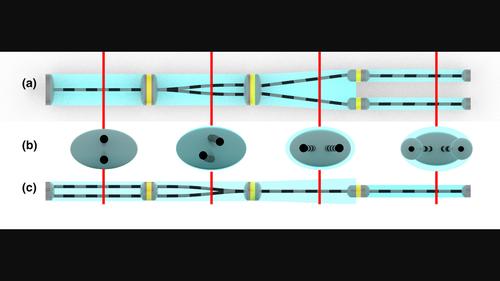Our official English website, www.x-mol.net, welcomes your
feedback! (Note: you will need to create a separate account there.)
Fin systems comparative anatomy in model Batoidea Raja asterias and Torpedo marmorata: Insights and relatioships between musculo-skeletal layout, locomotion and morphology
Journal of Anatomy ( IF 1.8 ) Pub Date : 2023-05-01 , DOI: 10.1111/joa.13881 Ugo E Pazzaglia 1, 2 , Marcella Reguzzoni 2 , Renata Manconi 3 , Luca Lanteri 4 , Guido Zarattini 1 , Piero A Zecca 2 , Mario Raspanti 2
Journal of Anatomy ( IF 1.8 ) Pub Date : 2023-05-01 , DOI: 10.1111/joa.13881 Ugo E Pazzaglia 1, 2 , Marcella Reguzzoni 2 , Renata Manconi 3 , Luca Lanteri 4 , Guido Zarattini 1 , Piero A Zecca 2 , Mario Raspanti 2
Affiliation

|
The macroscopic and microscopic morphology of the appendicular skeleton was studied in the two species Raja asterias (order Rajiformes) and Torpedo marmorata (Order Torpediniformes), comparing the organization and structural layout of pectoral, pelvic, and tail fin systems. The shape, surface area and portance of the T. marmorata pectoral fin system (hydrodynamic lift) were conditioned by the presence of the two electric organs in the disk central part, which reduced the pectoral fin surface area, suggesting a lower efficiency of the “flapping effectors” than those of R. asterias. Otherwise, radials' rays alignment, morphology and calcification pattern showed in both species the same structural layout characterized in the fin medial zone by stiffly paired columns of calcified tiles in the perpendicular plane to the flat batoid body, then revolving and in the horizontal plane to continue as separate mono-columnar rays in the fin lateral zone with a morphology suggesting fin stiffness variance between medial/lateral zone. Pelvic fins morphology was alike in the two species, however with different calcified tiles patterns of the 1st compound radial and pterygia in respect to the fin-rays articulating perpendicularly to the latter, whose tile rows lay-out was also different from that of the pectoral fins radials. The T. marmorata tail-caudal fin showed a muscular and connective scaffold capable of a significant oscillatory forward thrust. On the contrary, the R. asterias dorsal tail fins were stiffened by a scaffold of radials-like calcified segments. Histomorphology, heat-deproteination technique and morphometry provided new data on the wing-fins structural layout which can be correlated to the mechanics of the Batoid swimming behavior and suggested a cartilage-calcification process combining interstitial cartilage growth (as that of all vertebrates anlagen) and a mineral deposition with accretion of individual centers (the tiles). The resulting layout showed scattered zones of un-mineralized matrix within the calcified mass and a less compact texture of the matrix calcified fibers suggesting a possible way of fluid diffusion throughout the mineralized tissue. These observations could explain the survival of the embedded chondrocytes in absence of a canalicular system as that of the cortical bone.
中文翻译:

Batoidea Raja asterias 和 Torpedo marmorata 模型中鳍系统的比较解剖学:肌肉骨骼布局、运动和形态之间的见解和关系
研究了Raja asterias(Rajiformes目)和Torpedo marmorata(Order Torpediniformes)两个物种的附肢骨骼的宏观和微观形态,比较了胸鳍、骨盆和尾鳍系统的组织和结构布局。T. marmorata胸鳍系统(流体动力升力)的形状、表面积和重要性受到圆盘中央部分两个电器官的存在的影响,这减少了胸鳍表面积,表明“水动力升力”的效率较低。扑动效应器”比R. asterias的效应器更重要。另外,两个物种的桡骨射线排列、形态和钙化模式显示出相同的结构布局,其特征是在鳍内侧区域,在与扁平蝙蝠体垂直的平面上有刚性配对的钙化瓦片柱,然后旋转并在水平面中在鳍外侧区域中继续作为单独的单柱射线,其形态表明内侧/外侧区域之间的鳍刚度差异。两个物种的腹鳍形态相似,但第一复合桡骨和翼状胬肉的钙化瓦片图案与垂直于后者的鳍条不同,其瓦片排布局也与胸鳍的不同。翅片呈放射状。T. marmorata尾鳍显示出肌肉发达且结缔的支架,能够产生显着的振荡向前推力。相反,R. asterias 的背尾鳍因放射状钙化节段的支架而变得僵硬。组织形态学、热脱蛋白技术和形态测量学提供了有关翼鳍结构布局的新数据,这些数据可与 Batoid 游泳行为的力学相关,并提出了一种结合间质软骨生长(如所有脊椎动物原基)和软骨钙化过程的软骨钙化过程。带有单个中心(瓦片)增生的矿物沉积。由此产生的布局显示钙化块内分散的未矿化基质区域和基质钙化纤维的不太致密的纹理表明流体在整个矿化组织中扩散的可能方式。这些观察结果可以解释嵌入的软骨细胞在没有小管系统的情况下与皮质骨一样的存活。
更新日期:2023-05-01
中文翻译:

Batoidea Raja asterias 和 Torpedo marmorata 模型中鳍系统的比较解剖学:肌肉骨骼布局、运动和形态之间的见解和关系
研究了Raja asterias(Rajiformes目)和Torpedo marmorata(Order Torpediniformes)两个物种的附肢骨骼的宏观和微观形态,比较了胸鳍、骨盆和尾鳍系统的组织和结构布局。T. marmorata胸鳍系统(流体动力升力)的形状、表面积和重要性受到圆盘中央部分两个电器官的存在的影响,这减少了胸鳍表面积,表明“水动力升力”的效率较低。扑动效应器”比R. asterias的效应器更重要。另外,两个物种的桡骨射线排列、形态和钙化模式显示出相同的结构布局,其特征是在鳍内侧区域,在与扁平蝙蝠体垂直的平面上有刚性配对的钙化瓦片柱,然后旋转并在水平面中在鳍外侧区域中继续作为单独的单柱射线,其形态表明内侧/外侧区域之间的鳍刚度差异。两个物种的腹鳍形态相似,但第一复合桡骨和翼状胬肉的钙化瓦片图案与垂直于后者的鳍条不同,其瓦片排布局也与胸鳍的不同。翅片呈放射状。T. marmorata尾鳍显示出肌肉发达且结缔的支架,能够产生显着的振荡向前推力。相反,R. asterias 的背尾鳍因放射状钙化节段的支架而变得僵硬。组织形态学、热脱蛋白技术和形态测量学提供了有关翼鳍结构布局的新数据,这些数据可与 Batoid 游泳行为的力学相关,并提出了一种结合间质软骨生长(如所有脊椎动物原基)和软骨钙化过程的软骨钙化过程。带有单个中心(瓦片)增生的矿物沉积。由此产生的布局显示钙化块内分散的未矿化基质区域和基质钙化纤维的不太致密的纹理表明流体在整个矿化组织中扩散的可能方式。这些观察结果可以解释嵌入的软骨细胞在没有小管系统的情况下与皮质骨一样的存活。





















































 京公网安备 11010802027423号
京公网安备 11010802027423号